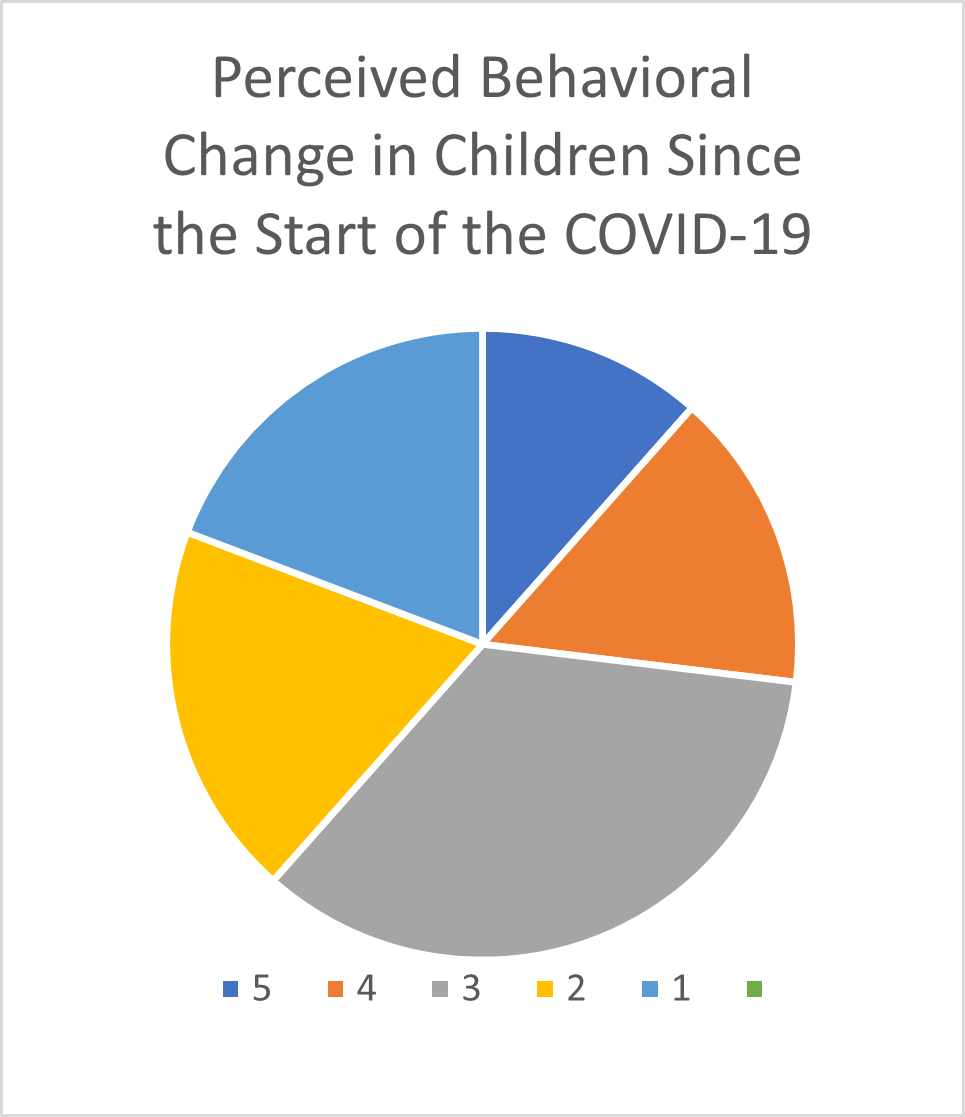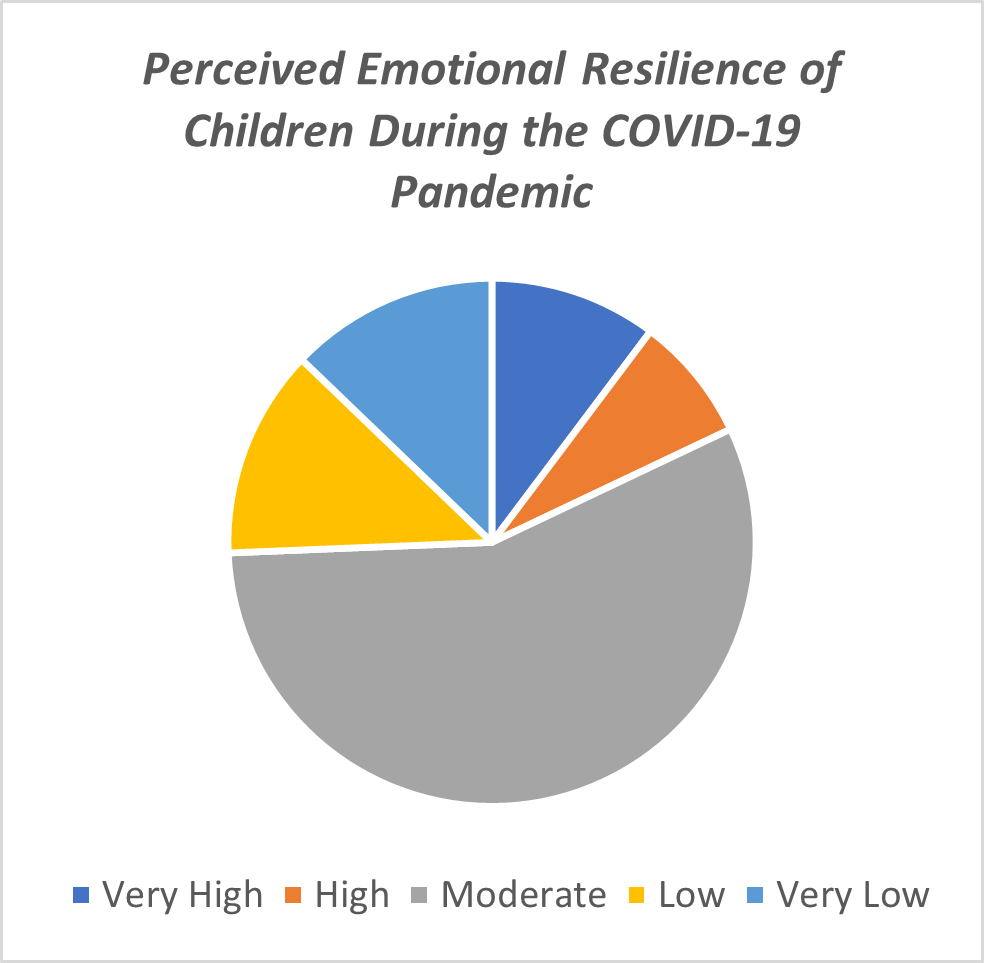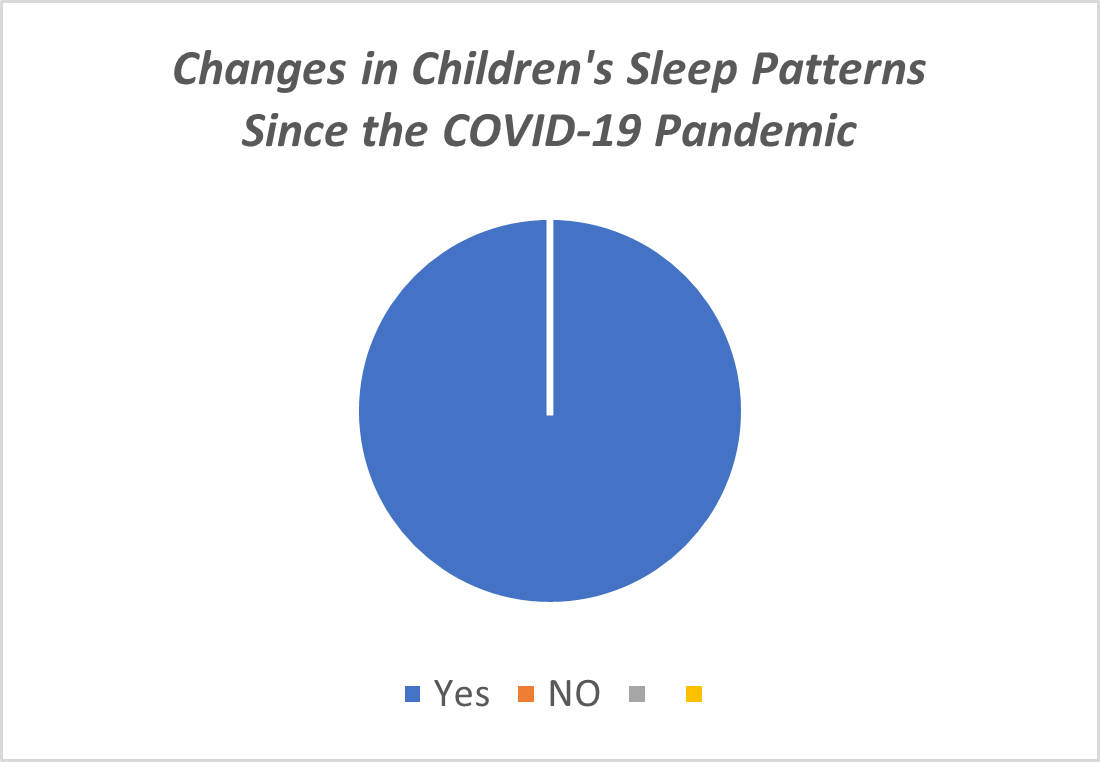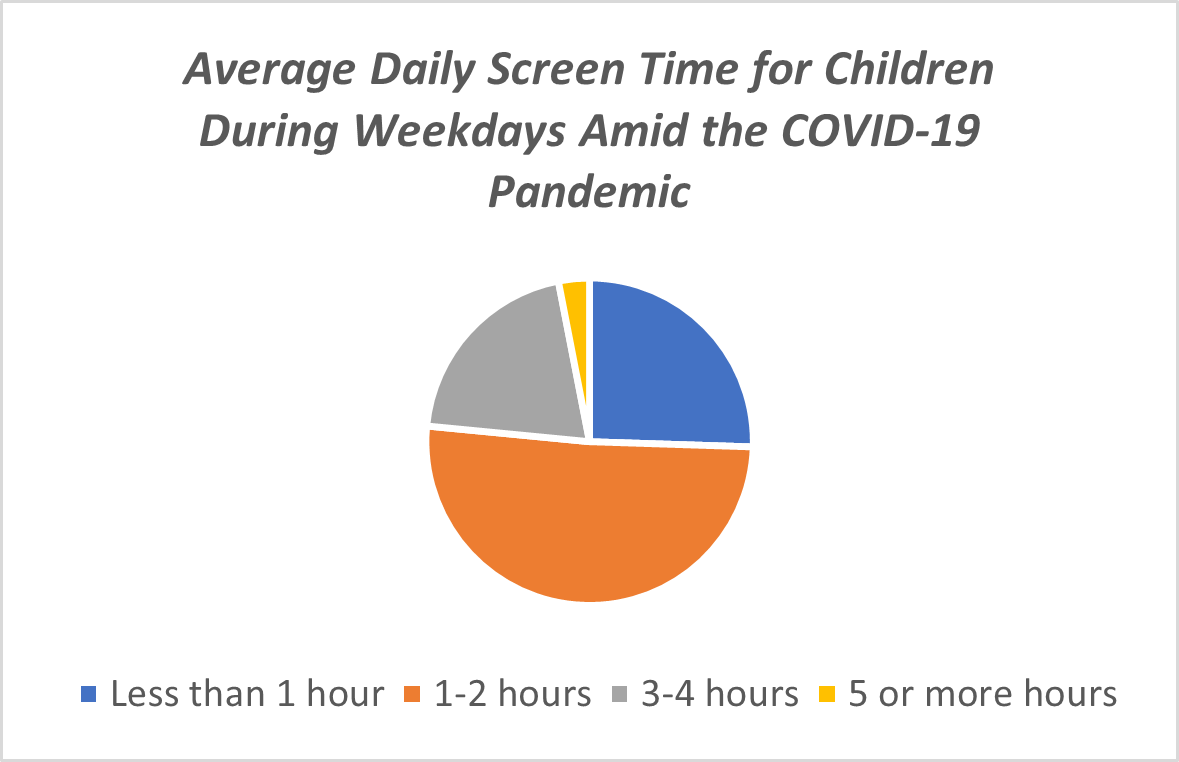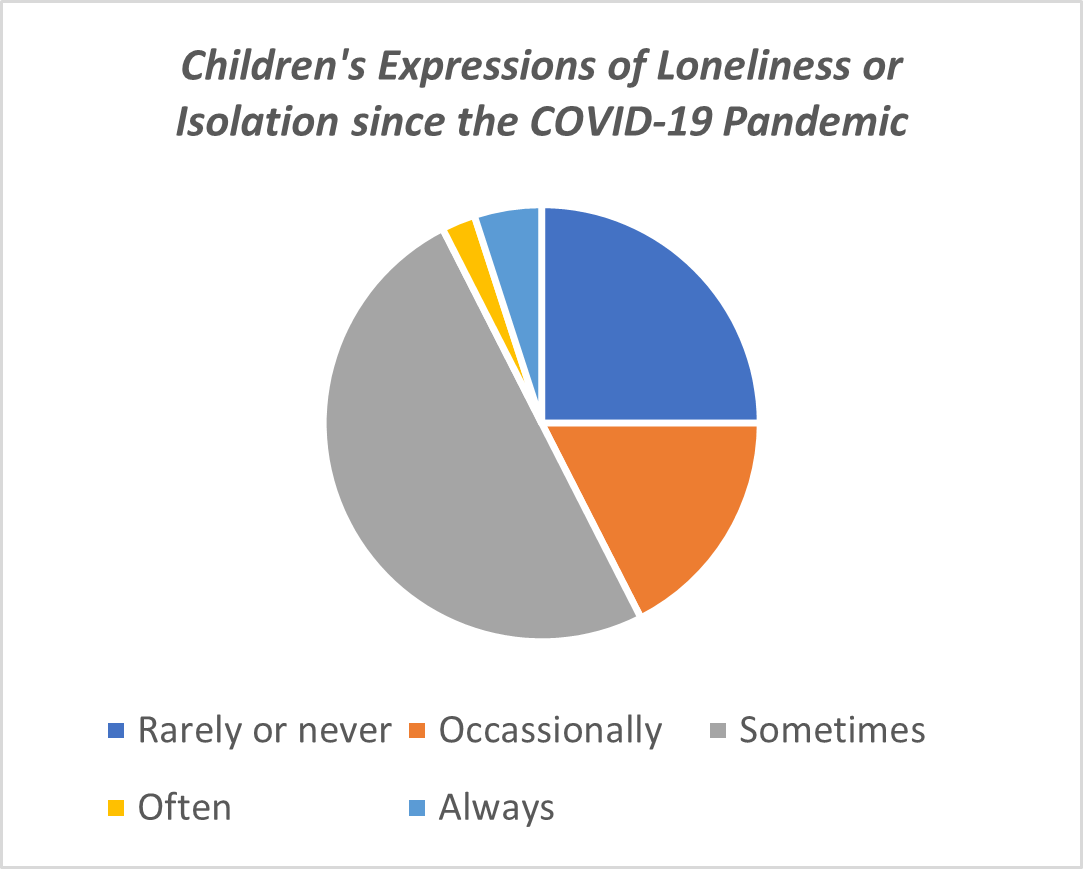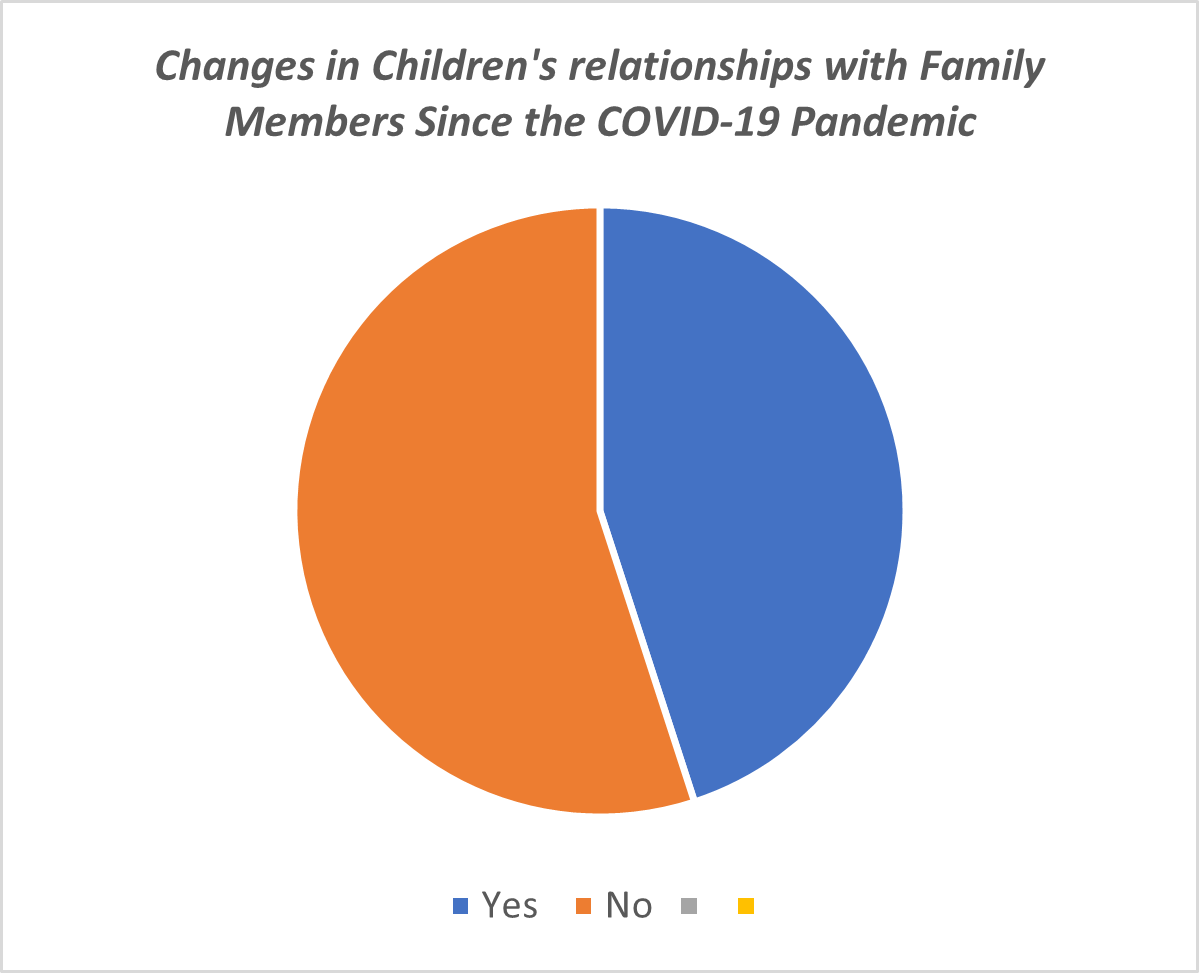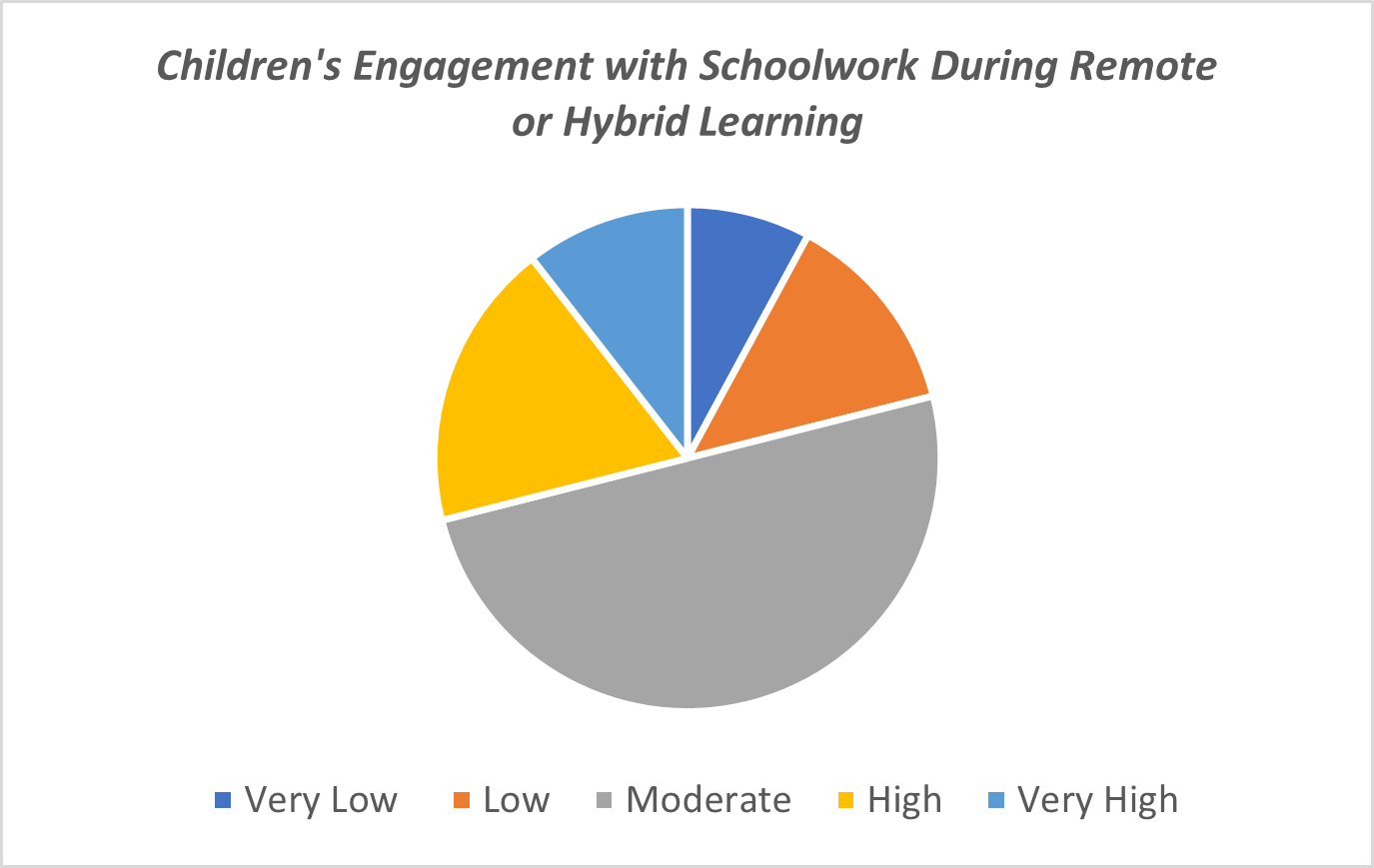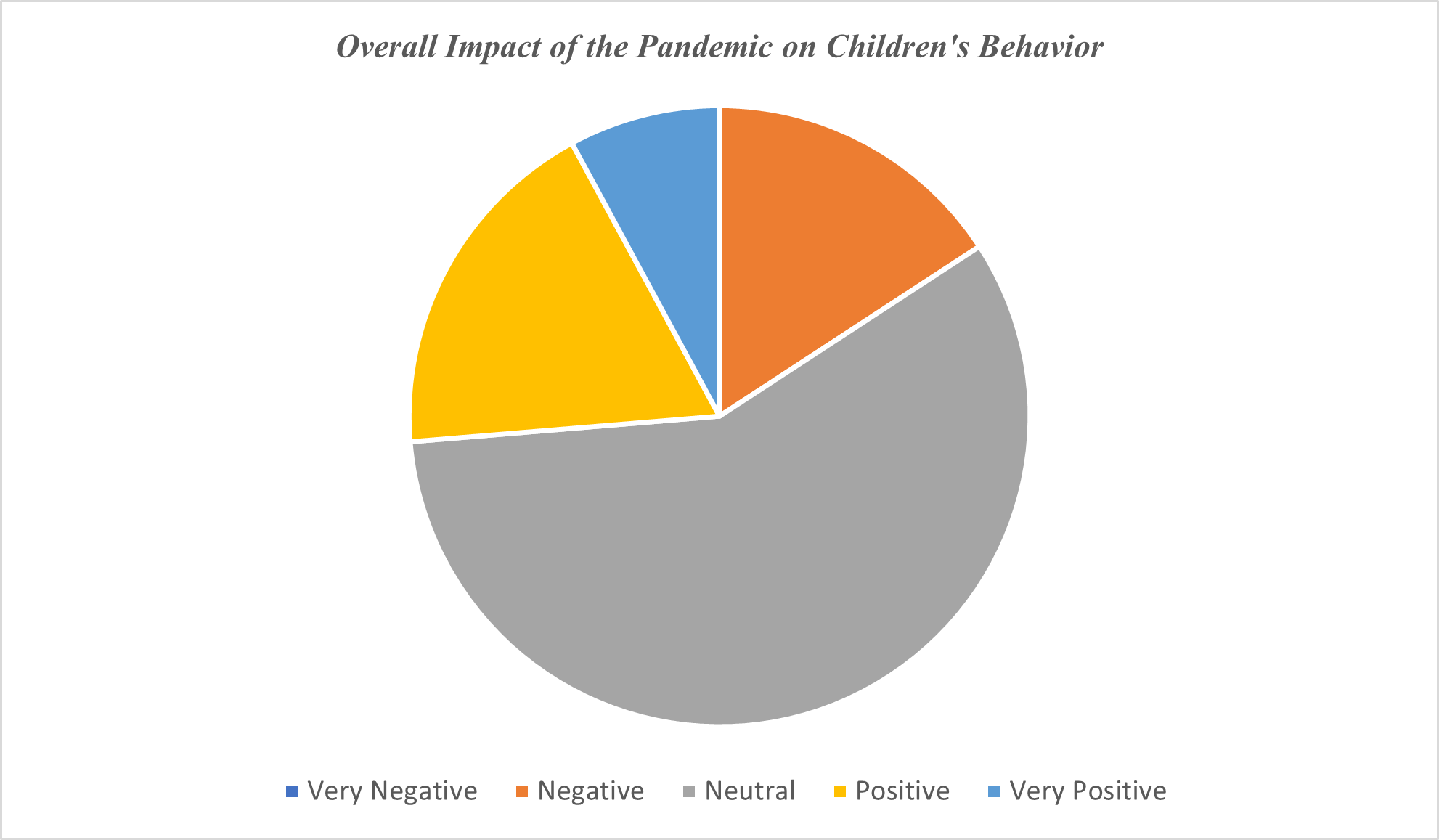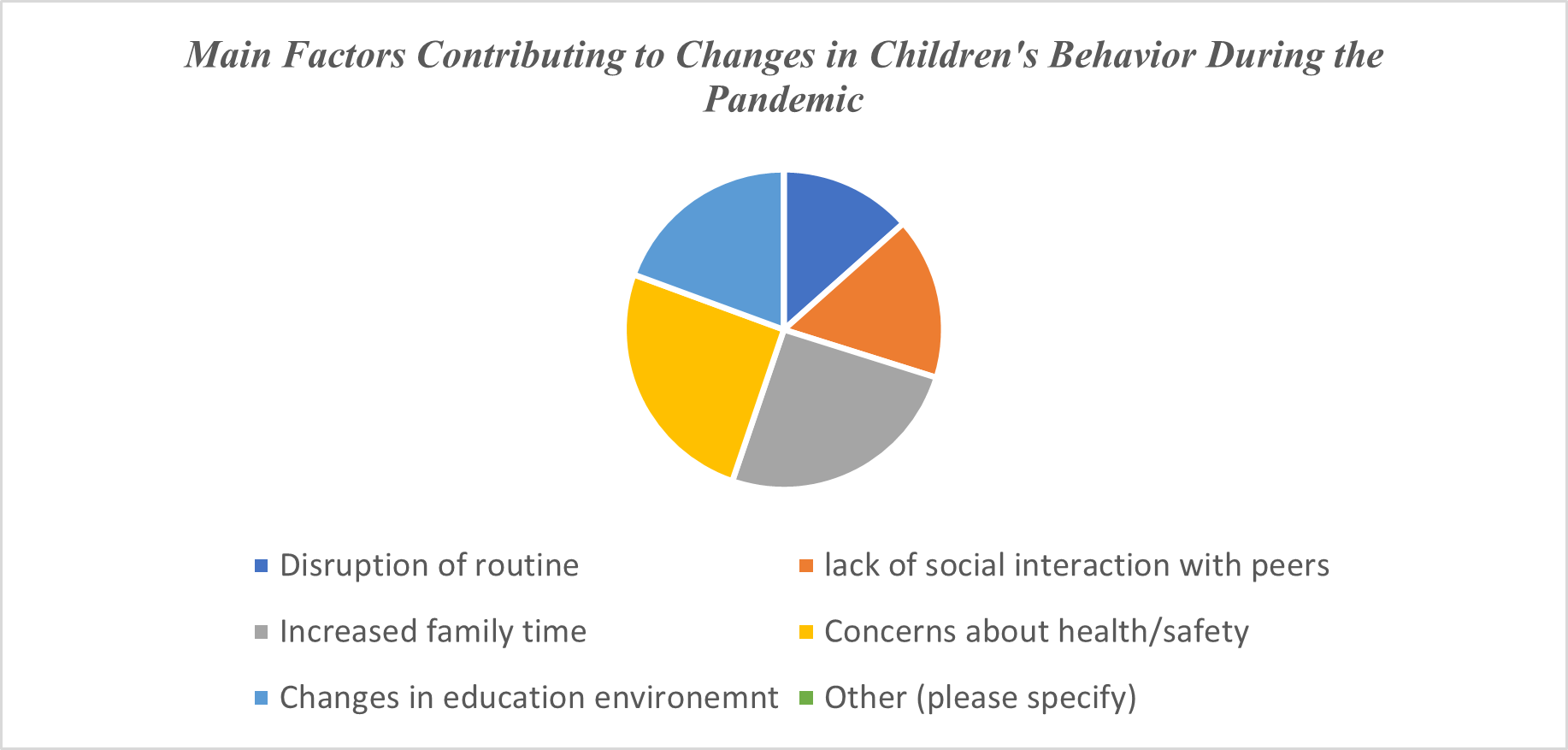Investigating the Impact of the Covid-19 Pandemic on Elementary Students’ Behavioral Patterns: An Action Research Study
- Abamonga, Maricris C., LPT, Ed.D.
- Combuan, Margelyn C., LPT
- 2343-2356
- Jul 16, 2024
- Education
Investigating the Impact of the Covid-19 Pandemic on Elementary Students’ Behavioral Patterns: An Action Research Study
Abamonga, Maricris C., LPT, Ed.D., Combuan, Margelyn C., LPT
Philippine Science High School – Caraga Region Campus, Philippines
DOI: https://dx.doi.org/10.47772/IJRISS.2024.806177
Received: 12 June 2024; Accepted: 18 June 2024; Published: 16 July 2024
ABSTRACT
This action research study investigates the impact of the COVID-19 pandemic on the behavioral patterns of elementary students. Using a mixed-methods approach, the research collected data through surveys, focus groups, and interviews involving teachers, parents, and students. The findings revealed significant behavioral changes, such as increased anxiety, social withdrawal, and challenges in maintaining attention and motivation during remote learning. Some students, however, demonstrated resilience and adaptability, developing new skills and coping mechanisms. The study provides actionable recommendations for educators, parents, and policymakers to support elementary students in overcoming these challenges, emphasizing the importance of fostering supportive learning environments, enhancing social-emotional learning, and promoting mental health. The research highlights the need for ongoing monitoring and tailored interventions to address the long-term behavioral impacts of the pandemic on young learners.
Keywords: Impact, COVID-19, Elementary Students, Behavioral Patterns, Action Research
INTRODUCTION
The COVID-19 pandemic has triggered unprecedented disruptions to various aspects of daily life, profoundly impacting individuals of all ages worldwide. Among the most vulnerable groups affected by these disruptions are elementary students, whose developmental trajectories have been significantly influenced by the multifaceted challenges posed by the pandemic. As schools transitioned to remote learning modalities, social interactions were curtailed, and familial dynamics underwent significant shifts in response to health and economic uncertainties. These changes have raised critical questions about the impact of the pandemic on elementary students’ behavioral patterns and well-being.
Purpose and objectives
The purpose of this analysis is to provide a comprehensive examination of the impact of the COVID-19 pandemic on elementary students’ behavioral patterns. Through a systematic exploration of the various factors at play, this analysis seeks to elucidate the complex interplay between environmental influences and students’ behavioral responses during this challenging period. The objectives of this analysis are as follows:
1. To assess changes in elementary students’ behavioral patterns before, during, and after the COVID-19 pandemic, including social interactions, emotional regulation, and academic engagement.
2. To investigate the factors contributing to shifts in behavioral patterns among elementary students during the pandemic, such as remote learning, social distancing measures, and changes in family dynamics.
3. To identify effective interventions and support systems aimed at promoting resilience and addressing behavioral challenges among elementary students in response to the COVID-19 pandemic.
Scope and Limitations
This analysis focuses primarily on elementary students aged 6 to 12 years old and their behavioral responses to the COVID-19 pandemic. It encompasses a broad range of behavioral patterns, including but not limited to social interactions, emotional regulation, and academic engagement. The analysis will draw on a combination of quantitative data, qualitative insights, and theoretical frameworks to provide a comprehensive understanding of the subject under examination.
However, it is essential to acknowledge certain limitations inherent in this analysis. Due to the rapidly evolving nature of the pandemic and the diversity of contexts in which elementary students reside, the findings may not fully capture every nuance or variation in behavioral responses. Additionally, the availability and quality of data may vary across different regions, potentially limiting the generalizability of the findings. Despite these limitations, this analysis aims to contribute valuable insights into the impact of the COVID-19 pandemic on elementary students’ behavioral patterns and inform targeted interventions to support their well-being.
BACKGROUND INFORMATION
In examining the impact of the COVID-19 pandemic on elementary students’ behavioral patterns, several contextual factors prove significant. The educational landscape is pivotal, with the prevalence of remote learning, access to technology, and schools’ adaptability shaping students’ experiences. Socioeconomic factors play a crucial role, as disparities in resources like stable internet access and supportive home environments can exacerbate inequalities. Additionally, health and safety measures, such as social distancing protocols, impact students’ routines and interactions. Changes in family dynamics, influenced by factors like parental employment and financial stress, also affect students’ well-being. Community support systems, including access to mental health services and extracurricular activities, can mitigate pandemic-related stressors. Cultural norms and government policies further shape responses, highlighting the need to consider broader socio-political contexts when analyzing students’ behavioral patterns.
The historical background surrounding the impact of the COVID-19 pandemic on elementary students’ behavioral patterns is marked by a series of unprecedented events and responses. Emerging in late 2019, the novel coronavirus quickly spread globally, leading to the declaration of a pandemic by the World Health Organization in March 2020. This declaration prompted widespread measures to curb the spread of the virus, including school closures, lockdowns, and social distancing mandates. For elementary students, these measures resulted in a sudden shift to remote learning modalities, disrupting traditional schooling routines and social interactions. The pandemic also exposed and exacerbated pre-existing societal inequalities, with marginalized communities disproportionately affected by limited access to resources and support systems. As countries implemented various strategies to mitigate the health and economic impacts of the pandemic, the education sector faced unprecedented challenges in ensuring continuity of learning while safeguarding students’ well-being. Understanding this historical context is crucial for comprehensively analyzing the multifaceted impact of the COVID-19 pandemic on elementary students’ behavioral patterns.
Numerous stakeholders and entities are integral to addressing the impact of the COVID-19 pandemic on elementary students’ behavioral patterns. Government agencies at various levels implement public health measures and education policies to safeguard students’ well-being. School administrators and teachers play pivotal roles in adapting educational practices, offering support, and promoting social-emotional development. Parents and families provide crucial support at home, collaborating with schools and ensuring conducive learning environments. Healthcare professionals offer expertise in addressing students’ mental health needs, while community organizations provide additional resources and social connections. Technology and telecommunication companies facilitate remote learning by providing essential infrastructure and resources. Research institutions and academia contribute knowledge through empirical studies and evidence-based interventions. Policy makers and advocacy groups advocate for policies and funding to support students’ needs, while international organizations coordinate global efforts to address the pandemic’s impact on children’s education and well-being. By engaging with these stakeholders collaboratively, comprehensive efforts can be made to mitigate the pandemic’s effects and promote the holistic development of elementary students.
METHODOLOGY
The approach used for analyzing the impact of the COVID-19 pandemic on elementary students’ behavioral patterns typically involves a multi-faceted and interdisciplinary methodology. Firstly, quantitative analyses may be conducted to assess changes in behavioral patterns before, during, and after the pandemic, utilizing survey data, standardized assessments, or administrative records. These quantitative approaches allow for the examination of trends, correlations, and statistical significance in students’ behaviors across different time periods and demographic groups. Additionally, qualitative methods such as interviews, focus groups, or case studies may be employed to capture the nuanced experiences and perspectives of students, parents, teachers, and other stakeholders. Qualitative analyses provide rich, in-depth insights into the social, emotional, and contextual factors shaping students’ behaviors during the pandemic. Furthermore, theoretical frameworks such as the Ecological Systems Theory or Social Cognitive Theory may be applied to interpret and contextualize the findings, considering the complex interactions between individual, interpersonal, and environmental factors. By employing a comprehensive approach that integrates quantitative and qualitative methods, alongside theoretical perspectives, researchers can gain a holistic understanding of the impact of the pandemic on elementary students’ behavioral patterns, informing evidence-based interventions and support strategies.
Description of data sources and collection methods
The data sources through survey, interviews and observational studies conducted with elementary students, parents, teachers and other stakeholders. The survey has been administered through survey questionnaire, interviews on the other hand, have been conducted to gather qualitative insights into students’ experiences and perspectives during the pandemic, providing more in-depth information on the factors influencing their behavior.
For the student-participants, the informed consent was obtained, the confidentiality and anonymity were ensured, the standardized measures or interview protocols were employed in order to maintain consistency across data collection.
The sample size consists of 40 individuals, encompassing parents, guardians, and pupils affiliated with Cogon Central Elementary School. This diverse group was selected to provide comprehensive insights into the impact of the COVID-19 pandemic on elementary students’ behavioral patterns from multiple perspectives. Parents and guardians offer valuable insights into the home environment, support systems, and challenges faced by students outside of school settings. Meanwhile, pupils themselves provide firsthand accounts of their experiences, emotions, and behavioral responses to the pandemic. The sample size of 40 was determined to ensure adequate representation while maintaining feasibility in data collection and analysis. By including stakeholders from different roles within the school community, this approach aims to capture a holistic understanding of how the pandemic has influenced behavioral patterns among elementary students at Cogon Central Elementary School.
For this simple survey questionnaire for elementary school pupils, no specific tool or framework was explicitly utilized. However, the questions were designed to capture key aspects of the impact of the COVID-19 pandemic on students’ behavioral patterns, drawing from common themes and concerns identified in literature and prior research. While the questionnaire does not adhere to a specific theoretical framework or methodological tool, it aims to gather qualitative insights into students’ experiences and perspectives during the pandemic.
In the absence of a specific tool or framework in this simple survey questionnaire, the focus is on eliciting direct responses from elementary school pupils to gain insights into their experiences and perceptions regarding the impact of the COVID-19 pandemic on their behavioral patterns.
ANALYSIS
- Demographic Profile
Table 1.1 Age Distribution of the Respondents
| Age | No. of Respondents | Percentage |
| 6-7 years old | 0 | 0% |
| 8-9 years old | 6 | 15.00% |
| 10-11 years old | 17 | 42.50% |
| 12 and above | 0 | 0% |
| Others please specify | 17 | 42.5% |
The group of 8-9-year-old students comprises 10 respondents, representing a smaller portion of the sample. This age group is in a critical developmental stage, transitioning from early childhood into more structured learning environments. Their behavioral changes due to the pandemic might be distinct, as they are adapting to more formal education while still requiring significant emotional and social support.
The 10-11-year-old group, with 34 respondents, forms the largest segment of the sample. This age range typically includes students in upper elementary grades who are more independent and have established learning habits. The impact of the pandemic on this group is particularly significant, as these students are at a crucial stage for developing advanced academic skills and social competencies. The larger sample size in this category allows for a more detailed analysis of how these students have adapted to changes in their learning environment and social structures.
The remaining 34 respondents fall into the category of ‘other ages,’ encompassing students from 6-7 years old and those who are 12 years old. This diverse group includes both younger students who are just beginning their formal education and older elementary students who are preparing to transition to middle school. The behavioral impacts on these students may vary widely due to their different developmental stages and educational needs. Analyzing this group provides insights into the broader spectrum of elementary students’ experiences during the pandemic.
The age distribution of respondents provides a comprehensive view of the varied impacts of the COVID-19 pandemic on elementary students. The larger sample size in the 10-11 years old category suggests a focus on the experiences of students in upper elementary grades, while the smaller sample sizes in the 8-9 years old and other ages categories indicate the need to consider unique developmental and behavioral challenges faced by younger and older elementary students. This age-based analysis will enable a nuanced understanding of how different age groups have responded to the pandemic’s disruptions, informing targeted strategies to support their behavioral and educational needs.
Table 1.2. Sex Distribution of the Respondents
| Sex | Nos. of Respondents | Percentage |
| Male | 19 | 47.5% |
| Female | 21 | 52.5% |
The sex-disaggregated data shows a balanced sample, with a slight predominance of females (21) over males (19). This balance is beneficial for a comprehensive analysis, allowing for comparisons between the sexes to determine if and how the pandemic has differently affected boys and girls in elementary school.
Table 1.3. Relationship of the Respondents to the pupil.
| Respondents | Nos. of Respondents | Percentage |
| Parent | 37 | 92.5% |
| Guardian | 3 | 7.5 % |
| Others (Please Specify) | 0 | 0 % |
The study’s sample includes 40 respondents, with 37 being parents (92.5%) and 3 being guardians (7.5%), providing insights into the impact of the COVID-19 pandemic on elementary students’ behavior. The majority parental perspective offers detailed observations on daily behavioral changes, emotional states, and academic engagement, given their direct and continuous interaction with their children. Parents can elaborate on alterations in home environments, social interactions, and coping mechanisms during the pandemic. Meanwhile, the smaller group of guardians adds valuable perspectives on alternative caregiving arrangements and the children’s adaptation to new routines, highlighting the challenges and support systems for non-parent caregivers. Together, these insights ensure a comprehensive understanding of the pandemic’s effects on children’s behavior, facilitating the development of targeted interventions to support their well-being across different caregiving contexts.
- Behavioral Changes
The COVID-19 pandemic has significantly disrupted the lives of elementary students, leading to profound changes in their behavioral patterns. This study, drawing on insights from a sample of 40 respondents predominantly composed of parents, examines the multifaceted impacts on children’s behavior. The analysis reveals notable shifts in daily routines, emotional resilience, social interactions, and academic engagement. Parents, providing the bulk of the data, observed increased anxiety, altered sleep patterns, and greater dependence on digital devices for entertainment and learning. Guardians, though fewer, highlighted the challenges of transitioning to new caregiving environments and the adaptability of children to these changes. These findings underscore the pandemic’s diverse effects on elementary students, emphasizing the need for targeted strategies to support their mental health, social development, and academic progress during this unprecedented period.
Chart 2.1 On a scale of 1 to 5, where 1 is “Not at all” and 5 is “significantly”, how much do you feel your child’s behavior has changed since the start of the COVID-19 pandemic?
The analysis of respondents’ ratings on the perceived behavioral changes in their children since the start of the COVID-19 pandemic reveals a diverse impact. Among the 40 respondents, 3 reported significant changes (rating 5), and 4 observed considerable changes (rating 4), together comprising 17.5% of the sample. Meanwhile, 9 respondents (22.5%) noted moderate changes (rating 3), making it the most common response. Conversely, 10 respondents, split equally between ratings 1 and 2, indicated minimal to no change, representing 25% of the sample. This distribution suggests that while some children have experienced significant behavioral shifts due to the pandemic, a considerable portion has shown only moderate or minimal changes. These findings underscore the necessity for tailored interventions to address the varied degrees of impact, focusing on those who have been significantly affected while also supporting those with moderate changes to prevent further negative effects (Jiao et al., 2020).
Chart 2.2. How would you rate your child’s level of emotional resilience during the pandemic?
The analysis of respondents’ ratings on their child’s level of emotional resilience during the COVID-19 pandemic provides insightful findings. Out of 40 respondents, the majority (22 respondents, or 55%) rated their child’s emotional resilience as moderate. A smaller portion of the sample exhibited high (3 respondents, or 7.5%) and very high (4 respondents, or 10%) levels of emotional resilience, together comprising 17.5%. On the lower end of the spectrum, 5 respondents (12.5%) rated their child’s emotional resilience as low, and another 5 (12.5%) rated it as very low. This distribution indicates that while a majority of children displayed a moderate level of emotional resilience during the pandemic, a significant number struggled with low to very low resilience, and a smaller group demonstrated high resilience. These findings highlight the varied emotional responses among children, emphasizing the need for targeted emotional support programs to bolster resilience in those with lower ratings while continuing to nurture resilience in those who are coping well (Glynn et al., 2020).
Chart 2.3 Have you noticed any changes in your child’s sleep patterns since the pandemic began?
The data on changes in children’s sleep patterns since the start of the COVID-19 pandemic shows an equal split among respondents. Out of 40 respondents, 20 (50%) reported noticing changes in their child’s sleep patterns, while the other 20 (50%) reported no changes. This indicates that the pandemic’s impact on sleep patterns has been significant for half of the children, suggesting disruptions possibly due to altered daily routines, increased screen time, or stress and anxiety. Conversely, the other half of the respondents did not observe any changes, indicating that some children’s sleep routines remained stable despite the challenges posed by the pandemic (Becker & Gregory, 2020).
Chart 2.4. On average, how many hours does your child spend engaged in screen time activities (e.g., watching TV, using computers/ tablets, playing video games) per day during weekdays?
The majority of children, representing 50% of the sample, spend between 1 to 2 hours per day engaged in screen time activities. This suggests a moderate level of screen time usage, potentially balancing educational and recreational screen activities. About a quarter of the children (25%) spend less than 1 hour on screens, indicating limited exposure. However, 20% of children engage in 3 to 4 hours of screen time daily, which may indicate increased reliance on digital devices for various activities. Only a small percentage (2.5%) spends 5 or more hours on screens, highlighting that extended screen time is less common among the respondents. These findings underscore the importance of monitoring and managing children’s screen time to promote healthy digital habits and overall well-being.
Chart 2.5. How does your child express feelings of loneliness or isolation since the pandemic began?
The data on how children express feelings of loneliness or isolation since the pandemic began reveals a range of experiences among the respondents. Out of 40 respondents, half of the children (50%) sometimes express feelings of loneliness or isolation, indicating that these feelings are relatively common but not constant. A smaller group of children, 17.5%, occasionally experience these feelings, while 20% rarely or never feel lonely or isolated. Notably, 12.5% of the children express these feelings often or always, pointing to a subset of children who are significantly affected by loneliness and isolation. This distribution highlights that while many children experience intermittent feelings of loneliness, there is a critical need to support those who are more frequently affected to help mitigate the negative emotional impacts of the pandemic (Loades et al., 2020).
Chart 2.6 Have you observed any changes in your child’s relationships with family members (e.g., siblings, parents) since the pandemic began?
The data on observed changes in children’s relationships with family members since the start of the COVID-19 pandemic shows a nearly even split among respondents. Out of 40 respondents, 18 (45%) reported observing changes in their child’s relationships with family members, such as siblings and parents. In contrast, 22 respondents (55%) did not notice any changes. This indicates that while a significant number of children experienced shifts in family dynamics, the majority maintained stable relationships. The observed changes could reflect both positive and negative impacts, such as increased bonding or heightened tensions due to prolonged close contact. The findings suggest that while many families adapted well to the altered circumstances, a considerable portion faced challenges that affected their interpersonal relationships, highlighting the importance of family support systems during such disruptive periods (Bubb & Jones, 2020).
Chart 2.7. How would you rate your child’s level of engagement with schoolwork during remote or hybrid learning?
The data on children’s level of engagement with schoolwork during remote or hybrid learning reveals varying levels of participation and interest. Among 40 respondents only 38 responded: 3 children for very low (7.9%), 5 children for low (13.2%), 19 children (50%) for moderate, 7 children (18.4%) for high and 4 children (10.5%) for very high.
Half of the children (50%) have a moderate level of engagement with their schoolwork, suggesting that they are somewhat involved but not highly enthusiastic or motivated. A combined 21.1% of children have low to very low engagement, indicating a notable portion struggling with remote or hybrid learning formats. Conversely, 28.9% of children have high to very high engagement, reflecting a substantial group that is actively participating and adapting well to these learning environments. These findings highlight the diverse experiences and engagement levels among students, emphasizing the need for tailored strategies to support those with lower engagement and to maintain the motivation of those who are more engaged.
- Impact Assessment
The COVID-19 pandemic has profoundly affected various aspects of life, particularly for elementary school students who faced unprecedented disruptions in their education and daily routines. This study aims to assess the impact of the pandemic on children’s behavioral patterns, emotional resilience, sleep patterns, feelings of loneliness, family relationships, and engagement with schoolwork. By gathering data from parents and guardians, the study provides a comprehensive analysis of how these young students have adapted to the challenges posed by remote or hybrid learning environments and social isolation. The findings offer valuable insights into the varied responses and adaptations among children, highlighting the need for targeted interventions to support their mental health, academic engagement, and overall well-being during and after the pandemic.
Chart 3.1 How would you rate the overall impact of the pandemic on your child’s behavior?
The data on the overall impact of the pandemic on children’s behavior shows a range of perceptions among the respondents. Out of 40 respondents 38 responded and indicated very negative with 0 children (0%), negative with 6 children (15.8%), neutral with 22 children (57.9%), positive with 7 children (18.4%) and very positive with 3 children (7.9%).
The majority of respondents (57.9%) perceive the overall impact of the pandemic on their child’s behavior as neutral, indicating that for many children, their behavior remained relatively stable despite the disruptions caused by the pandemic. A smaller group, 15.8%, reported a negative impact, suggesting that these children experienced some behavioral challenges during this period. Conversely, 26.3% of respondents observed a positive impact (18.4% positive and 7.9% very positive), highlighting that some children adapted well and perhaps even benefited behaviorally from the changes in their environment. Notably, none of the respondents rated the impact as very negative. These findings suggest that while the pandemic posed challenges for some children, many maintained stable behavior, and a significant portion showed positive behavioral adjustments (Imran et al., 2020).
Chart 3.2. In your opinion, what are the main factors contributing to any changes in your child’s behavior during the pandemic? Select all that apply.
Results of the Focus Group Discussion of Teachers
The interviews with teachers reveal significant behavioral challenges among students during the pandemic. Teachers have observed that many students are struggling with behavior management, exhibiting signs of restlessness, irritability, and a lack of discipline that was not as prevalent before the pandemic. This behavioral shift is attributed to the disruptions in daily routines and the stress of adapting to new learning environments. The lack of structured schedules at home and reduced physical activities have compounded these issues, leading to increased behavioral problems in the classroom setting, whether virtual or in-person.
Teachers have also noted a marked decline in students’ classroom participation. Students who were once active and engaged are now frequently unresponsive and disengaged. The virtual learning environment has made it difficult for teachers to foster the same level of interaction and participation as in a traditional classroom. Many students seem distracted, often not participating in discussions, and failing to complete assignments on time. This decline in participation is a significant concern as it affects the overall learning experience and the development of essential communication skills.
Another critical issue highlighted by teachers is the lack of attentiveness among students. With the shift to remote and hybrid learning models, maintaining students’ attention has become increasingly challenging. The home environment is rife with distractions, from household noises to easy access to non-educational digital content. Teachers report that students often appear disengaged, with short attention spans, frequently turning off cameras, and not responding when called upon. This lack of attentiveness severely impacts their ability to absorb and retain information presented during lessons.
The culmination of behavioral challenges, reduced classroom participation, and lack of attentiveness has had a tangible impact on students’ academic performance. Teachers report that the results of student assessments have been notably lower compared to pre-pandemic levels. Many students are failing to meet the expected learning outcomes, and there is a noticeable decline in the quality of their work. This is particularly concerning as it indicates that the disruptions caused by the pandemic are not only affecting students’ current academic performance but may also have long-term implications on their educational development and future prospects.
The teacher interviews provide a clear picture of the significant challenges faced by elementary students during the pandemic. Behavioral issues, lack of participation, and decreased attentiveness are prevalent, leading to lower academic performance. These findings underscore the urgent need for targeted interventions to address these issues, including enhanced emotional and behavioral support, strategies to improve engagement in remote learning environments, and measures to help students regain their focus and motivation in the classroom.
SUMMARY
The study examined the impact of the COVID-19 pandemic on elementary students’ behavior, emotional well-being, and academic performance through a combination of quantitative data analysis and qualitative teacher interviews. The quantitative analysis revealed a range of behavioral changes among students, with a significant proportion experiencing moderate to significant shifts. Emotional resilience varied among students, indicating diverse responses to the challenges posed by the pandemic. Additionally, students’ engagement with schoolwork during remote or hybrid learning showed a diverse range, with many struggling to maintain consistent participation and attention.
Complementing the quantitative findings, teacher interviews provided valuable insights into the challenges faced by students. Teachers reported behavioral issues, decreased classroom participation, and a lack of attentiveness among students, which have contributed to declining academic performance. These challenges are attributed to the disruptions caused by the pandemic and difficulties in adapting to new learning environments.
Finally, the study highlights the complex and multifaceted impacts of the COVID-19 pandemic on elementary students, encompassing behavioral, emotional, and academic dimensions. Urgent interventions are needed to address these challenges and support students in navigating the ongoing disruptions to their education. Collaboration between schools, families, and communities will be essential in implementing effective strategies to mitigate the negative effects of the pandemic and promote the well-being and academic success of elementary students.
CONCLUSION
The findings from both the data analysis and teacher interviews paint a concerning picture of the impact of the COVID-19 pandemic on elementary students’ behavior and academic performance. The data revealed a range of behavioral changes among students, with a significant portion experiencing moderate to significant shifts. Additionally, emotional resilience varied among students, with some showing high levels while others struggled with low resilience. Sleep patterns, feelings of loneliness, and family relationships were also affected to varying degrees. Furthermore, students’ engagement with schoolwork during remote or hybrid learning showed a diverse range, with many struggling to maintain consistent participation and attention.
The teacher interviews provided further insight into the challenges faced by students, including behavioral issues, decreased classroom participation, and a lack of attentiveness. Teachers expressed concerns about students’ declining academic performance, attributing it to the disruptions caused by the pandemic and the difficulties in adapting to new learning environments.
In conclusion, the combined findings highlight the multifaceted impacts of the pandemic on elementary students, encompassing behavioral, emotional, and academic dimensions. Urgent interventions are needed to address these challenges and support students in navigating the ongoing disruptions to their education. Strategies should focus on providing comprehensive emotional and behavioral support, enhancing engagement in remote learning settings, and implementing measures to mitigate the negative effects on academic performance. Collaboration between schools, families, and communities will be essential in implementing these interventions effectively and ensuring the well-being and academic success of elementary students during and beyond the pandemic.
RECOMMENDATIONS
Based on the summary of findings, several key recommendations can be made to support elementary students in coping with the behavioral and emotional challenges posed by the COVID-19 pandemic:
- Schools and communities should increase access to counseling services and mental health resources to address the diverse emotional needs of children. Implementing programs that include regular mental health check-ins can help identify and support children with low resilience or high levels of loneliness.
- Parents and educators should collaborate to ensure a healthy balance of screen time. Encouraging physical activities, outdoor play, and hobbies that do not involve screens can help reduce the negative effects of prolonged screen exposure.
- Establishing and maintaining daily routines can provide children with a sense of stability. Schools can support parents by offering guidelines on creating structured schedules that balance educational activities, recreational time, and rest.
- Schools and communities should create safe opportunities for social interaction, such as virtual group activities, online playdates, or carefully managed in-person events following health guidelines. This can help mitigate feelings of isolation and loneliness among children.
- To maximize the positive impact of increased family time, schools and community organizations should offer family support programs, including parenting workshops and family counseling, to help families navigate changes in their dynamics and strengthen relationships.
- Providing clear, age-appropriate information about health and safety can help reduce children’s anxiety and concerns. Schools should incorporate health education into their curriculum to keep students informed and promote a sense of security.
- Schools should continue to develop and refine remote and hybrid learning models to maintain high levels of student engagement. Incorporating interactive and diverse teaching methods can help keep students interested and motivated in their schoolwork.
- Implementing regular surveys and feedback mechanisms can help schools monitor changes in students’ behavior, emotional health, and engagement. This ongoing assessment will enable timely adjustments to support strategies and ensure that they effectively address students’ needs.
- Policymakers and community leaders should prioritize funding and resources for mental health services, educational technology, and family support initiatives. Collaborative efforts between schools, communities, and governments are essential to addressing the multifaceted impacts of the pandemic on children.
Implementing these recommendations can help mitigate the adverse effects of the COVID-19 pandemic on elementary students and foster a supportive environment that promotes their overall well-being and development.
REFERENCES
- Bandura, A. (1986). Social foundations of thought and action: A social cognitive theory. Prentice-Hall.
- Becker, S. P., & Gregory, A. M. (2020). Editorial Perspective: Perils and promise for child and adolescent sleep and associated psychopathology during the COVID-19 pandemic. Journal of Child Psychology and Psychiatry, 61(7), 757-759.
- Bronfenbrenner, U. (1979). The ecology of human development: Experiments by nature and design. Harvard University Press.
- Bubb, S., & Jones, M.-A. (2020). Learning from the COVID-19 home-schooling experience: Listening to pupils, parents/carers and teachers. Improving Schools, 23(3), 209-222.
- Creswell, J. W., & Creswell, J. D. (2017). Research design: Qualitative, quantitative, and mixed methods approaches (5th ed.). SAGE Publications.
- Cruz, R. S., Hernandez, J. M., Tan, M. L., Flores, P. B., & Gonzales, A. S. (2021). Parental Perceptions of the Impact of COVID-19 on Children’s Education in the Philippines. Philippine Journal of Psychology, 54(1), 45-59.
- Garcia, A. B., Santos, E. C., Dela Cruz, F. D., & Ramirez, G. H. (2021). Challenges and Opportunities of Blended Learning for Elementary Students in the Philippines. Philippine Journal of Education, 70(2), 45-58.
- Glynn, L. M., Davis, E. P., Luby, J. L., Baram, T. Z., & Sandman, C. A. (2020). A predictable home environment may protect child mental health during the COVID-19 pandemic. Neurobiology of Stress, 14, 100291.
- Hernandez, L. M., Cruz, M. S., Reyes, N. B., Tan, R. C., & Fernandez, S. M. (2020). Impact of COVID-19 on School Attendance and Academic Performance of Elementary Students in the Philippines. Philippine Journal of Educational Research and Evaluation, 24(1), 10-22.
- Imran, N., Aamer, I., Sharif, M. I., Bodla, Z. H., & Naveed, S. (2020). Psychological burden of quarantine in children and adolescents: A rapid systematic review and proposed solutions. Pakistan Journal of Medical Sciences, 36(5), 1106
- Jiao, W. Y., Wang, L. N., Liu, J., Fang, S. F., Jiao, F. Y., Pettoello-Mantovani, M., … & Hoang, T. (2020). Behavioral and Emotional Disorders in Children during the COVID-19 Epidemic. The Journal of Pediatrics, 221, 264-266.
- Loades, M. E., Chatburn, E., Higson-Sweeney, N., Reynolds, S., Shafran, R., Brigden, A., … & Crawley, E. (2020). Rapid Systematic Review: The Impact of Social Isolation and Loneliness on the Mental Health of Children and Adolescents in the Context of COVID-19. Journal of the American Academy of Child & Adolescent Psychiatry, 59(11), 1218-1239.
- Merriam, S. B. (2009). Qualitative research: A guide to design and implementation. Jossey-Bass.
- Miles, M. B., Huberman, A. M., & Saldana, J. (2013). Qualitative data analysis: A methods sourcebook. SAGE Publications.
- National Association of School Psychologists. (2021). COVID-19 Resource Center. Retrieved from https://www.nasponline.org/resources-and-publications/resources-and-podcasts/covid-19-resources
- National Center for Biotechnology Information. (2021). Socioeconomic status and child development. Retrieved from https://www.ncbi.nlm.nih.gov/books/NBK109222/
- Ravens-Sieberer, U., Kaman, A., Erhart, M., Devine, J., Schlack, R., & Otto, C. (2021). Impact of the COVID-19 Pandemic on Quality of Life and Mental Health in Children and Adolescents in Germany. European Child & Adolescent Psychiatry, 30(1), 27-37.
- Reyes, M. R., Rivera, R. P., Panganiban, L. C., Regalado, M. M., Tiu, L. C., & Cheng, T. (2020). Effects of the COVID-19 Pandemic on the Mental Health of Filipino Children and Adolescents. Philippine Journal of Child Health, 18(1), 8-20.
- Sahu, P., Mathew, R., & Das, N. (2020). Impact of COVID-19 on Children: Special Focus on the Psychosocial Aspect. Minerva Pediatrica, 72(3), 226-235.
- Santos, J. R., Cruz, M. A., Garcia, N. B., Fernandez, R. S., & Reyes, L. M. (2021). Remote Learning Challenges and Coping Mechanisms of Elementary Students in the Philippines. Philippine Journal of Educational Research and Evaluation, 25(2), 24-36.
- Spinelli, M., Lionetti, F., Pastore, M., & Fasolo, M. (2020). Parents’ Stress and Children’s Psychological Problems in Families Facing the COVID-19 Outbreak in Italy. Frontiers in Psychology, 11, 1713.
- UNESCO. (2020). Education: From disruption to recovery. Retrieved from https://en.unesco.org/covid19/educationresponse
- United Nations. (2021). Policy brief: Education during COVID-19 and beyond. Retrieved from https://www.un.org/development/desa/dspd/wp-content/uploads/sites/22/2021/02/Policy-Brief-91.pdf
- World Health Organization. (2021). COVID-19: Health and safety measures for schools. Retrieved from https://www.who.int/news-room/q-a-detail/coronavirus-disease-covid-19-schools

